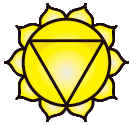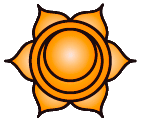How to Use Your Pendulum to Check the Status of Your Chakras
According to Barbara Ann Brennan, author of Hands of Light: A Guide to Healing Through the Human Energy Field, the best way to begin sensing the states of the chakras is to use a pendulum. A pendulum acts as an amplifier for the energy flow produced by each chakra. Observing how this energy manifests in the pendulum's swing can give you a great deal of information about your chakras.
 Keep in mind that the chakras are constantly adjusting as they go through different phases of opening and closing - adjusting and realigning to the overall body's ever-changing energy flows. An open chakra is good, but a closed one is not necessarily bad. It is a function of the body's energy system to vary the energy that flows through these portals. There are times when a closed chakra is necessary to the overall health of the individual as it processes issues related to that chakra.
Keep in mind that the chakras are constantly adjusting as they go through different phases of opening and closing - adjusting and realigning to the overall body's ever-changing energy flows. An open chakra is good, but a closed one is not necessarily bad. It is a function of the body's energy system to vary the energy that flows through these portals. There are times when a closed chakra is necessary to the overall health of the individual as it processes issues related to that chakra.
Important note: You don't need a special pendulum to do any of the following exercises. Any pendulum will work.
There are many different ways to use a pendulum to check the status of your chakras. Here are three methods:
1. Get help from a friend
This first method requires the assistance of another person. For this task you'll need a pendulum (does not need to be programmed) and a friend. Before beginning, be sure to state the source of your pendulum's answers. In order to get a good reading, it's essential that both you and your helper free your minds of any expected outcomes.
To get started, lie down on your back and have the other person hold a pendulum a few inches above your body at each chakra location, systematically writing down the direction and size of the pendulum swing for each. Turn over and repeat. Then, compare the two sets of readings for front and back. Look for differences in each chakra. Compare the swing size and look for differences there. A large swing means more energy is propelling it. A small swing, less energy. Ideally, each chakra will be "open" and produce a swing of approximately the same size throughout. More likely, however, there will be some differences among the various chakras, front and back. Identifying these that can help you pinpoint imbalances or blockages you'll want to address. Below is a table that shows how to interpret the pendulum readings.
| Pendulum Movement | Chakra State | Meaning |
| Clockwise | Open | Energy is in balance and flowing freely |
| Counterclockwise | Closed | Energy is restricted, out of balance, or blocked |
| Straight line (either direction) | Partially open/closed | Energy imbalance and/or partial blockage |
| Elliptical | Right/Left side imbalance | Energy is flowing, though out of balance on one or both sides |
| No movement | Blocked | No energy is moving through, full blockage |
2. Use a proxy
This is an entirely different way to analyze your chakras. This task requires a pendulum (does not need to be programmed) and a color printout of the symbols shown below. Use your own printer to print this page - or at least the part that contains the chakra symbols shown here.







Before beginning, be sure to state the source of your pendulum's answers. In this method, the printed page of chakra symbols becomes a proxy for your own body. Lay printed page on a desk or table. Quiet your mind and hold your pendulum above each chakra symbol. As you do, visualize the specific area on your own body that corresponds to the chakra. (Do not visualize what you think the pendulum should say though.) Record your readings and use the table above to interpret your results.
3. Use a chart
Another method is to use our Chakra Pendulum Chart show below. For this task you just need a pendulum (does not need to be programmed) and a chart. Before beginning, be sure to state the source of your pendulum's answers.

You can click on the image to purchase a pdf download of this chart at our Etsy shop - or if you prefer, draw your own on a blank piece of paper- using the chart here as a guide.
How to use chart: Lay the chart flat on a desk or table and hold your pendulum over the area at the center of the chart (where the pointer indicates). Ask your pendulum to identify specific states or energy levels. For example, you can ask "Show me which chakra has the highest energy today." Or, "Show me which chakra needs attention most right now." You can even ask specific questions designed to help narrow down issues that you may already be aware of. For instance, if you are feeling anxious, you could ask, "Which chakra is contributing to my sense of anxiety today?" Then study the attributes of that chakra (as listed on the chart) to see if you can focus in on the problem.
Remember to phrase your questions so that the pendulum can answer clearly. If you asked, "How are my chakras?" over this chart, your pendulum won't be able to answer because the question is too vague. A better way to phrase it is, "Show me which chakras are open" or "Show me which chakras are closed". You'd then read the pendulum as it swings directionally over the various wedges on the chart. Watch as it swings directionally through each wedge that fits the answer to your question. If only a few chakras are in open, the pendulum will swing through those and then may stop, or it may return to the first one indicated. If it swings in a clockwise circle, this indicates all chakras. Counter-clockwise indicates no chakras.

